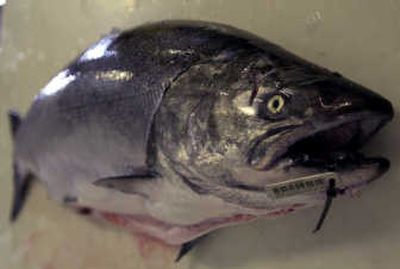Tracking project has funds, needs salmon

Scientists say they have the money to expand a research project that tracks where salmon go in the ocean.
But Gil Silvia of the Hatfield Marine Science Center in Newport, Ore., says the possible shutdown of ocean salmon fishing off Oregon and California could leave them with few fish to study.
Since 2006, scientists have collected genetic samples from salmon caught by Oregon fishermen and precise information on where they were caught in the ocean. The data has pinpointed which rivers the fish came from, which ultimately could allow fishermen to catch healthy stocks and leave weak stocks alone.
Plans call for expanding the program into California and Washington with the help of about $2 million in federal funding from a variety of sources.
Federal fisheries managers meeting in Seattle next week are considering whether to shut down salmon fishing off Oregon and California to protect record-low returns to the Sacramento River. It would be the most drastic salmon fishing closure in history.
One of the options they are considering is allowing a catch-and-release research fishery for this project. Trollers would be hired to catch chinook, clip a piece of a fin for genetic testing, and log the date and place they were caught and the water temperature.
But the council may decide that Sacramento River salmon are at such low numbers that even the small number of fish that would die after being released is too great.
As a backup, Silvia said they are working out an agreement with the whiting fleet to get the same information from the thousands of salmon that are caught inadvertently.
Silvia said the goal is to be able to target healthy salmon stocks while minimizing the catch of weak stocks and increase the scientific knowledge about salmon and to promote ocean-caught salmon as a product.
That is three to five years away, Silvia said.